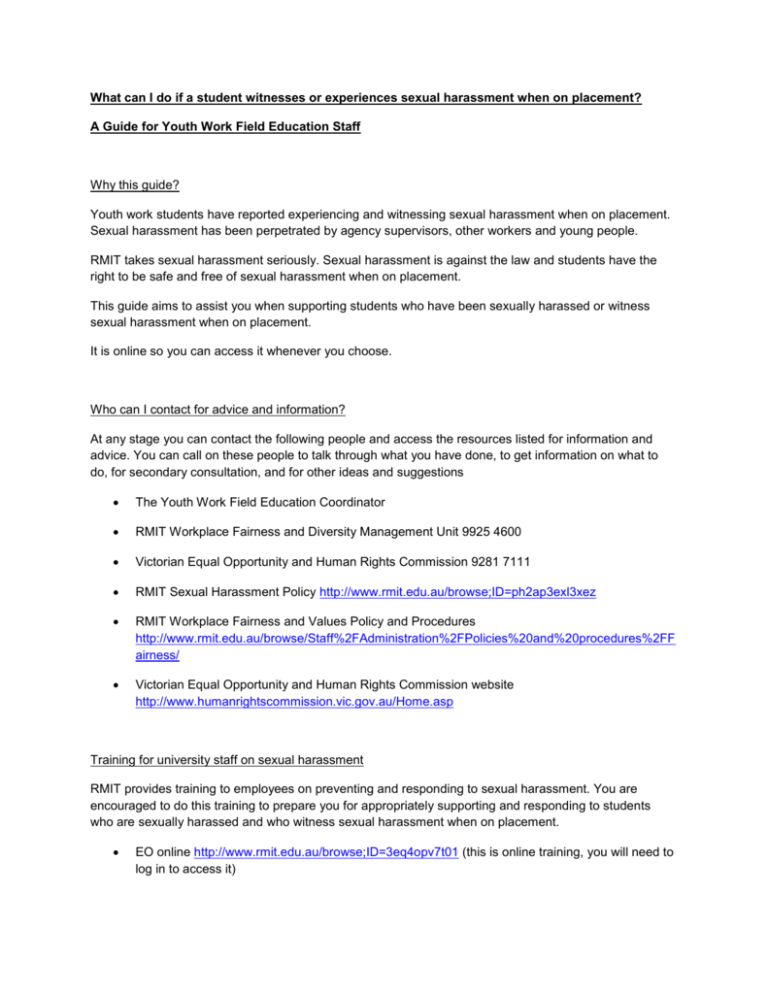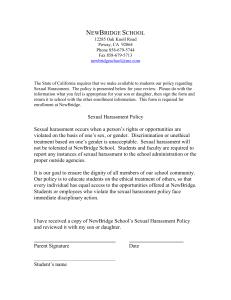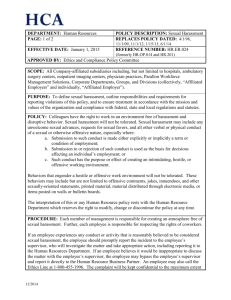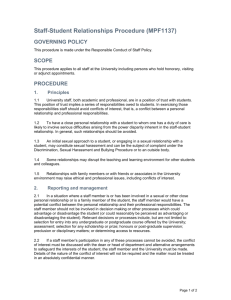
What can I do if a student witnesses or experiences sexual harassment when on placement?
A Guide for Youth Work Field Education Staff
Why this guide?
Youth work students have reported experiencing and witnessing sexual harassment when on placement.
Sexual harassment has been perpetrated by agency supervisors, other workers and young people.
RMIT takes sexual harassment seriously. Sexual harassment is against the law and students have the
right to be safe and free of sexual harassment when on placement.
This guide aims to assist you when supporting students who have been sexually harassed or witness
sexual harassment when on placement.
It is online so you can access it whenever you choose.
Who can I contact for advice and information?
At any stage you can contact the following people and access the resources listed for information and
advice. You can call on these people to talk through what you have done, to get information on what to
do, for secondary consultation, and for other ideas and suggestions
The Youth Work Field Education Coordinator
RMIT Workplace Fairness and Diversity Management Unit 9925 4600
Victorian Equal Opportunity and Human Rights Commission 9281 7111
RMIT Sexual Harassment Policy http://www.rmit.edu.au/browse;ID=ph2ap3exl3xez
RMIT Workplace Fairness and Values Policy and Procedures
http://www.rmit.edu.au/browse/Staff%2FAdministration%2FPolicies%20and%20procedures%2FF
airness/
Victorian Equal Opportunity and Human Rights Commission website
http://www.humanrightscommission.vic.gov.au/Home.asp
Training for university staff on sexual harassment
RMIT provides training to employees on preventing and responding to sexual harassment. You are
encouraged to do this training to prepare you for appropriately supporting and responding to students
who are sexually harassed and who witness sexual harassment when on placement.
EO online http://www.rmit.edu.au/browse;ID=3eq4opv7t01 (this is online training, you will need to
log in to access it)
Contact with the agency supervisor
You might have contact with the agency supervisor or other workers at the agency where the student is
doing placement regarding the harassment. If this is the case the agency should take the lead role in
responding to the harassment because it has occurred in the workplace.
There will be many occasions however when the student won’t raise the harassment in the workplace.
Reasons include; they don’t think it is serious enough, they think it is their fault, they fear negative
repercussions, they think it won’t be taken seriously; they don’t want to be labeled a ‘trouble-maker’, or it
could be the agency supervisor who is the offender. Don’t pressure the student to raise it with their
agency supervisor if they don’t want to, this is their decision. If it comes to your attention it is the
universities responsibility to support the student if it is not being addressed in the workplace.
If it is being addressed in the workplace ensure the following;
The agency has a sexual harassment policy and procedures (ask for a copy). If they don’t say
that RMIT does and that we will support them in responding, and make a time to meet with them.
Take to the meeting a copy of this guide, a copy of the RMIT sexual harassment policy, a copy of
the RMIT workplace fairness resource manual, and a copy of the Australian Human Rights
Commission (2008) Effectively preventing and responding to sexual harassment: A code of
practice for employers (links to these resources can be found below in the references)
Get assurances that the agency takes complaints of sexual harassment seriously and that the
safety of the student and their right to be in the workplace free of sexual harassment is the priority
Ask specifically what they will do next. Use this guide to assist with what they should do
Make a time to find out what has happened, within a week. Say you will call them
If needed follow up with the student
What is sexual harassment?
The Victorian Equal Opportunity and Human Rights Commission (2009) defines sexual harassment as;
‘Sexual harassment is conduct of a sexual nature that is unwelcome. Sexual harassment can be physical,
verbal or written. It involves behaviour that could reasonably be expected to make a person feel offended,
humiliated or intimidated. Sexual harassment is against the law.
Sexual harassment can involve:
an unwelcome sexual advance
a request for sexual favours
unwelcome comments about a person's sex life or physical appearance
suggestive behaviour such as leering and ogling
unnecessary physical intimacy such as brushing up against a person
sexually offensive comments, anecdotes or jokes
displaying sexually offensive visuals (such as photos, pinups or calendars), reading matter or
objects
sexual propositions or continued requests for dates
physical contact such as touching or fondling
indecent assault or rape (also criminal offences).’
Examples of sexual harassment
Youth work students are required to write online journals when on placement. Some students have used
the journals to report their experiences of sexual harassment. Examples include:
workers and young people speaking about their sex lives
workers and young people making sexually offensive comments
workers ogling young people
workers inappropriately commenting on service user’s physical appearance
young people harassing students to go out on dates and provide their contact details
What is not sexual harassment?
Sexual harassment is not behavior which is based on mutual attraction, friendship and respect. If the
interaction is consensual, welcome and reciprocated it is not sexual harassment.
The relationships between youth work students who on placement and agency supervisor, other workers
and young people are such that behavior of a sexual nature is most likely to be unwelcome, and breach
the ethical and legal boundaries of such relationships.
How might I find out a student has been sexually harassed?
a student tells you
you read it in a students online journal
another student tells you
someone else tells you (agency supervisor, other staff)
WHAT TO DO
1. Prepare the conversation, talk about confidentiality and keep a written record
respond promptly, contact the student as soon as possible
believe the student, don’t take an adversarial stance
get permission from the student to talk about it, ask, ‘is it ok for us to talk about this now?’
If the student does not want to talk about it:
let the student know you are there to talk to when they are ready
ask the student if they would like you to follow up with them in a few days, a week or a
couple of weeks?
refer the student to the guide for youth work students who experience or witness sexual
harassment when on placement, which is available on the field education blackboard site,
under the link ‘Policies’. Tell the student there is a list of other supports available to
students in this guide
inform the student you will be keeping a written record of the conversation that will remain
confidential. Date the record.
inform the student the conversation is confidential. This means you will not be talking with anyone
at the agency where the student is doing placement, or anyone else. However seek permission
from the student to inform the youth work field education coordinator. The purpose of informing
the youth work field education coordinator is to ensure future students are not sent to the agency.
Ask the student how they feel about this, and if the student does not want you to inform the youth
work field education coordinator let them know you won’t
2. Find out what happened and name sexual harassment
get a picture of what happened and what is going on. In particular the nature of the conduct of a
sexual nature that was unwelcome
find out how it is impacting on the student. Ask direct questions, ‘how do you feel about this?’ If
the student is feeling intimidated, scared, uncomfortable, offended, humiliated then this is a also
an indication that it is harassment
if the behavior is sexual harassment label it as sexual harassment (because the student might not
be doing this, be confused or unsure about this)
talk about who is responsible and that the student does not deserve to be treated this way, that it
is against the law and the student has the right to be safe from sexual harassment in the
workplace
3. Talk about safety and if required negotiate a safety plan
The student’s safety needs to be prioritized. Ask the student, ‘are you feeling unsafe, scared,
threatened, intimidated?’
If the student is unsafe do a safety plan. Talk about the following and provide ideas and advice:
is it possible to limit contact with the offender? How?
is it possible to ensure the student is not alone with the offender? How?
what might the student do if they are feeling unsafe, scared, threatened, intimidated?
What is the students plan for keeping themselves safe?
what might the student do if it happens again? Give permission for the student to speak
up, walk out, seek help
who might the student call on and contact for assistance and support? How can others in
the agency assist, who else could assist and provide advice?
when could and should the student contact you again?
4. Talk with the student about their options for dealing with sexual harassment and where to make a
complaint, get help and advice
find out what the student has done. Validate their decisions and actions (even if you think they
have been unhelpful), don’t criticize the student and provide other options for what they could do
talk about whether or not the student wants to do anything about it, this is there decision, and
they can decide at a later time, do they want some time to consider and for you follow up
let the student know that if they think they are being sexual harassed they can do one or more of
the following. Say that we appreciate students could feel more safe, comfortable and confident
doing some of the options compared to others, and what the student does is their choice
let the student know that they might want some time to consider what they want to do, and you
are happy for them to think about their options and follow up with them to talk more and support
them with what they decide to do
What follows is the list of options for students in the guide for youth work students who witness or
experience sexual harassment when in placement.
You can deal with the behavior yourself. You have every right to approach the other party and
ask them to stop the offending behavior
You can speak with your agency supervisor or another team leader or manager in the
organisation. The agency where you are doing placement should have a sexual harassment
policy and procedures to follow in order to remedy sexual harassment and deal with complaints.
Ask the student if they have spoken with their agency supervisor, or do they feel they could talk
with their agency supervisor (what if this is not possible? what is stopping them from doing this?).
Do not force the student to disclose to the agency supervisor or others at the agency. Students
can have good reasons for not doing so (such as fears of negative repercussions, further
harassment and getting labeled as a ‘trouble-maker’). Validate the student’s decision not to talk
with their agency supervisor and let them know this is their decision. Further this is something the
student would need to do, and not you as their university tutor. You can support them with what
they might say, and / or by attending a meeting with them at the agency for this to occur
You can contact your university tutor or the youth work field education coordinator
You can call RMIT counseling service on 9925 4365
http://www.rmit.edu.au/browse;ID=923iic1pajlw
You can contact RMIT student legal services on 9925 2078
http://www.rmit.edu.au/browse;ID=3y693xwqlu2u
You can contact the Victorian Equal Opportunity and Human Rights Commission 9281 7111
You can call the Centre Against Sexual Assault (CASA) 9344 2210
In the case of sexual assault you can contact the Victoria Police 000
In the case of unresolved or poorly handled complaints you can contact the RMIT Ombuds 9925
2930
5. Discuss the continuation or termination of placement, and on-going supervision
talk about whether or not the student wants to terminate placement. This could include sharing
our observations of whether or not placement should continue, but this is student’s decision. Talk
about how this would happen, the implications for assessment, and what would happen regarding
completing placement hours. Find out what the student wants to do and contact the field
education coordinator to discuss this further
the perpetrator could be the agency supervisor, or the student might not feel comfortable talking
about this concern with the agency supervisor. If this is the case it might require someone from
the university to step into a supervisory role with the student. Contact the field education
coordinator to discuss this further
6. Talk about self care and support
talk about the possible effects of sexual harassment; for example it can be stressful, and lead to
feelings of guilt, self-blame, fear and distress. Ask the student how they are coping and how it is
impacting on them
talk about the need for self care. Discuss with the student this might be something that they take
home with them. Ask, ‘how are you going to look after yourself during this?’, what can you do in
terms of self-care?’ Provide students with the RMIT student counseling service contact 9925
4365
find out who is the student getting support from; is it peers, family, partner, other workers at
agency? Talk with the student about how it can be distressing for others to hear someone close
to them and who they care about is being sexually harassed, and that it might have a negative
impact on relationships with significant others. Ask the student is this happening and talk about
the other supports available for the student to draw on if it is creating stress in other significant
relationships (eg. ’ Provide students with the RMIT student counseling service contact 9925 4365)
7. Offer follow up support
offer the student follow up and on-going support. Discuss and if agreed make a time for further
contact
8. Other follow up
to check you have responded appropriately you can contact the options listed at the beginning of
this guide
contact the youth work field education coordinator and provide an update. If the student has not
given permission to disclose do not disclose their name
References and further information
Australian Human Rights Commission (2008) Effectively preventing and responding to sexual
harassment: A code of practice for employers. Canberra: Human Rights and Equal Opportunity
Commission http://www.hreoc.gov.au/sexualharassment/index.html
RMIT University 2007 Policy: Sexual; harassment, RMIT University, Melbourne
http://www.rmit.edu.au/browse;ID=ph2ap3exl3xez
RMIT Workplace Fairness and Values Policies and Procedures
http://www.rmit.edu.au/browse/Staff%2FAdministration%2FPolicies%20and%20procedures%2FFairness/
Victorian Equal Opportunity and Human Rights Commission (2009) When is harassment against the law,
Victorian Equal Opportunity and Human Rights Commission
<http://www.humanrightscommission.vic.gov.au/Types%20of%20Discrimination/Sexual%20Harassment/
when%20are%20discrimination%20and%20harassment%20against%20the%20law.asp>.










